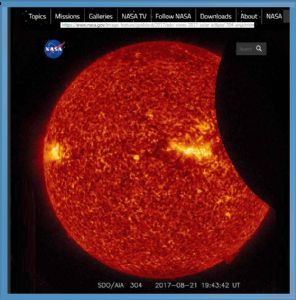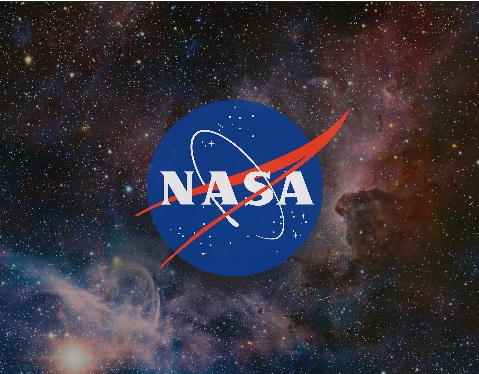|
SOLAR ECLİPSE
2017 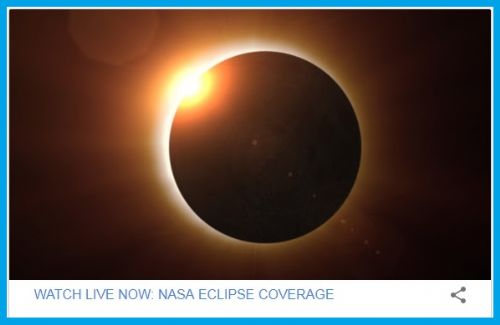
On August 21, 2017, All Of North America Was Treated To An
Eclipse Of The Sun. 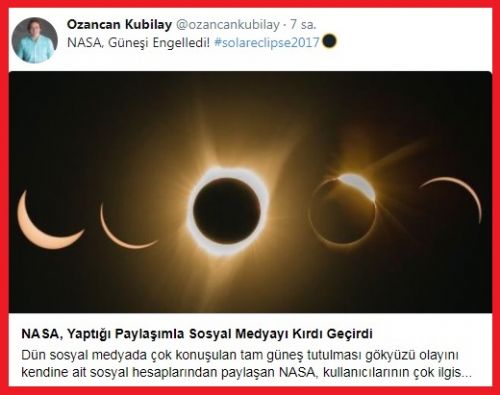
Viewers
around the world were provided a wealth of images captured
before, during, and after the eclipse by 11 spacecraft, at least three NASA
aircraft, more than 50 high-altitude balloons, and the astronauts aboard the
International Space Station – each offering a unique vantage point for the
celestial event.
Eclipse Photos From NASA
NASA Missions and People
Featured on NASA's Solar Eclipse Broadcast:
International Space Station, with astronauts Peggy Whitson, Randy Bresnik, Paolo Nespoli and Jack Fischer
Armstrong Flight Research Center's Gulfstream III aircraft, with Acting Administrator Lightfoot, Deputy Administrator Lesa
Roe and NASA Science Mission Directorate Associate Administrator Dr. Thomas Zurbuchen
NASA's WB-57F Jets
NOAA GOES Satellite Weather Imagery and Data
Solar Dynamics Observatory (SDO)
Parker Solar Probe
Solar and Heliospheric Observatory (SOHO)
Lunar Reconnaissance Orbiter
Kepler and SOFIA
Resources
NASA's Eclipse 2017 website
Safety Tips From NASA For Eclipse Viewing
Video: How to Safely Watch a Solar Eclipse
Watch NASA's Eclipse 2017 Preview Videos
Five Tips From NASA For Photographing the Total Solar
Eclipse
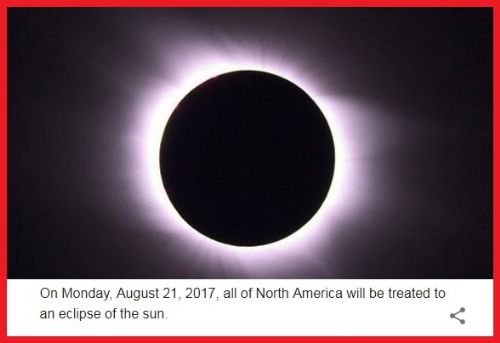
Julyg. 25, 2017
Chasing the Total Solar Eclipse from NASA’s WB-57F Jets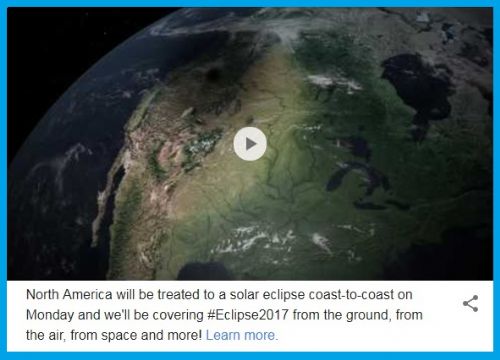
For most viewers,
the Aug. 21, 2017, total solar eclipse will last less than two and half
minutes.
But
for one team of NASA-funded scientists, the eclipse will last over seven
minutes. Their secret.?
Following
the shadow of the Moon in two retrofitted WB-57F jet planes.
Amir
Caspi of the Southwest Research Institute in Boulder, Colorado, and his team
will use two of NASA’s WB-57F research jets to chase the darkness across
America on Aug. 21. Taking observations from twin telescopes mounted on the
noses of the planes, Caspi will capture the clearest images of the Sun’s
outer atmosphere — the corona — to date and the first-ever thermal images of
Mercury, revealing how temperature varies across the planet’s surface.
“These
could well turn out to be the best ever observations of high frequency
phenomena in the corona,” says Dan Seaton, co-investigator of the project and
researcher at the University of Colorado in Boulder, Colorado. “Extending the
observing time and going to very high altitude might allow us to see a few
events or track waves that would be essentially invisible in just two minutes
of observations from the ground.”
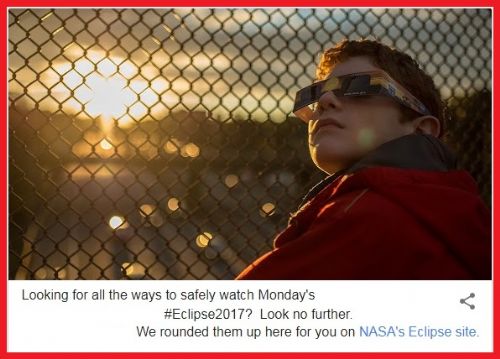
For
most viewers, the Aug. 21, 2017, total solar eclipse will last less than two
and half minutes. But for one team of NASA-funded scientists, the eclipse will
last over seven minutes. Their secret? Following the shadow of the Moon in two
retrofitted WB-57F jet planes. Amir Caspi of the Southwest Research Institute
in Boulder, Colorado, and his team will use two of NASA's WB-57F research jets
to chase the darkness across America on Aug. 21. Taking observations from twin
telescopes mounted on the noses of the planes, Caspi will capture the clearest
images of the Sun's outer atmosphere -- the corona -- to date and the
first-ever thermal images of Mercury, revealing how temperature varies across
the planet's surface.
Credits: NASA's Goddard
Space Flight Center
Download this video in HD formats from
NASA Goddard's Scientific Visualization Studio
The
total solar eclipse provides a rare opportunity for scientists to study the Sun,
particularly its atmosphere. As the Moon completely covers the Sun and
perfectly blocks its light during an eclipse, the typically faint corona is
easily seen against the dark sky. NASA is funding 11
science projects across
America for scientists to take advantage of the unique astronomical event to
learn more about the Sun and its effects on Earth’s upper atmosphere.
The corona
is heated to millions of degrees, yet the lower atmospheric layers like the
photosphere — the visible surface of the Sun — are only heated to a few
thousand degrees. Scientists aren’t sure how this inversion happens. One theory
proposes that magnetic waves called Alfvén waves steadily convey energy into
the Sun’s outer atmosphere, where it is then dissipated as heat. Alternatively,
micro explosions, termed nanoflares — too small and frequent to detect
individually, but with a large collective effect — might release heat into the
corona.

One
of the WB-57F jets is readied for a test run at NASA’s Johnson Space Center in
Houston. The instruments are mounted under the silver casing on the nose of the
plane.
Credits: NASA’s Johnson
Space Center/Norah Moran
Due
to technological limitations, no one has yet directly seen nanoflares, but the
high-resolution and high-speed images to be taken from the WB-57F jets might
reveal their effects on the corona. The high-definition pictures, captured 30
times per second, will be analyzed for wave motion in the corona to see if
waves move towards or away from the surface of the Sun, and with what strengths
and sizes.
“We
see the evidence of nanoflare heating, but we don’t know where they occur,”
Caspi said. “If they occur higher up in the corona, we might expect to see
waves moving downwards, as the little explosions occur and collectively
reconfigure the magnetic fields.”
In
this way, nanoflares may also be the missing link responsible for untangling
the chaotic mess of magnetic field lines on the surface of the Sun, explaining
why the corona has neat loops and smooth fans of magnetic fields. The direction
and nature of the waves observed will also help distinguish between competing
models of coronal heating. 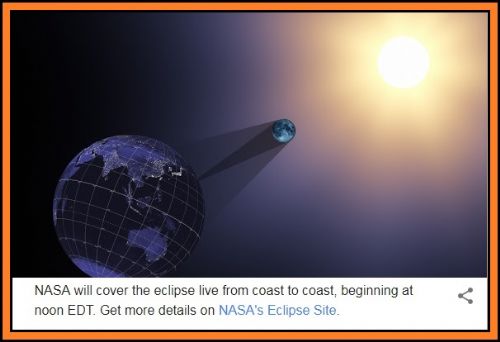
The
two planes, launching from Ellington Field near NASA’s Johnson Space Center in
Houston will observe the total eclipse for about three and a half minutes each
as they fly over Missouri, Illinois and Tennessee. By flying high in the
stratosphere, observations taken with onboard telescopes will avoid looking
through the majority of Earth’s atmosphere, greatly improving image quality. At
the planes’ cruising altitude of 50,000 feet, the sky is 20-30 times darker
than as seen from the ground, and there is much less atmospheric turbulence,
allowing fine structures and motions in the Sun’s corona to be visible.
Images
of the Sun will primarily be captured at visible light wavelengths,
specifically the green light given off by highly ionized iron, superheated by
the corona. This light is best for showing the fine structures in the Sun’s
outer atmosphere. These images are complementary to space-based telescopes,
like NASA’s Solar Dynamics Observatory, which takes images primarily in
ultraviolet light and does not have the capacity for the high-speed imagery
that can be captured aboard the WB-57F. 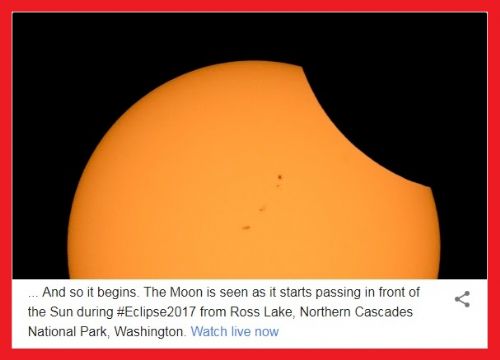
Observations
of Mercury will also be taken a half-hour before and after totality, when the
sky is still relatively dark. These images, taken in the infrared, will be the
first attempt to map the variation of temperature across the surface of the
planet.
Mercury
rotates much slower than Earth — one Mercurial day is approximately 59 Earth
days — so the night side cools to a few hundred degrees below zero while the
dayside bakes at a toasty 800 F. The images will show how quickly the surface
cools, allowing scientists to know what the soil is made of and how dense it
is. These results will give scientists insight into how Mercury and other rocky
planets may have formed.
The
images of the corona will also allow the team to search for a hypothesized
family of asteroids called vulcanoids. Its thought these objects orbit between
the Sun and Mercury, and are leftover from the formation of the solar system.
If discovered, vulcanoids could change what scientists understand about planet
formation.
Related Links 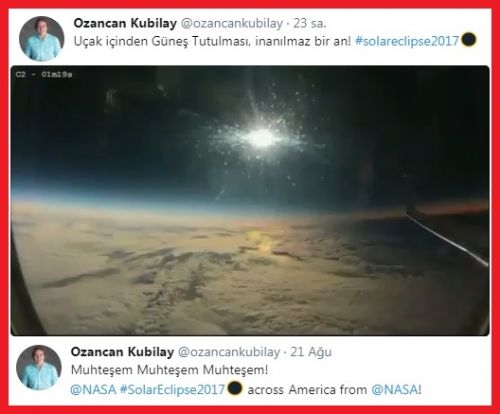
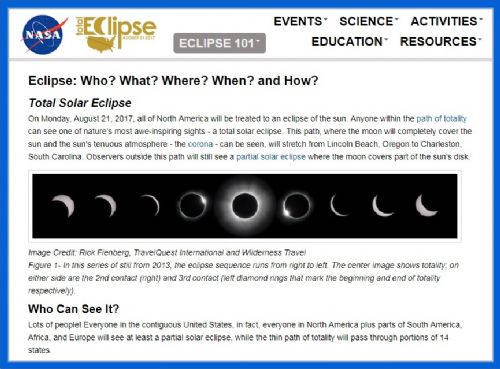
By Mara Johnson-Groh
NASA's
Goddard Space Flight Center, Greenbelt, Md.
Last Updated: Aug. 4,
2017
Editor: Rob Garner
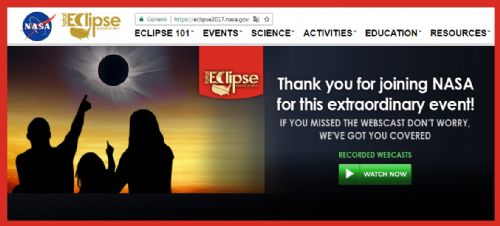
(Photo illustration) During
the upcoming total solar eclipse, a team of NASA-funded scientists will observe
the solar corona using stabilized telescopes aboard two of NASA’s WB-57F
research aircraft. This vantage point provides distinct advantages over
ground-based observations, as illustrated by this composite photo of the
aircraft and the 2015 total solar eclipse at the Faroe Islands.
Credits: NASA/Faroe
Islands/SwRI
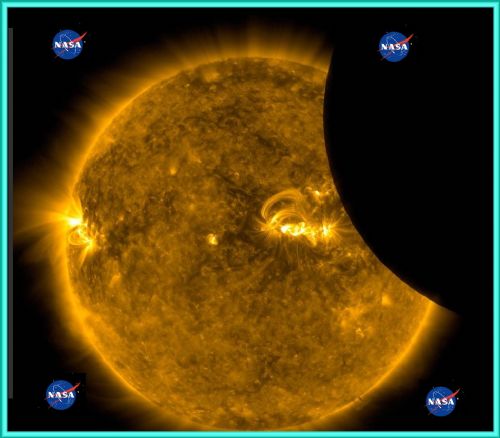
NASA's
EPIC View of 2017 Eclipse Across America
Aug. 22, 2017
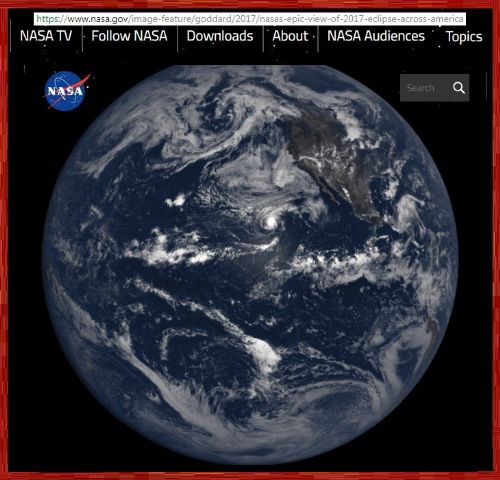
NASA
Earth Observatory: Eclipse Shadow Darkens the United States
Aug. 22, 2017
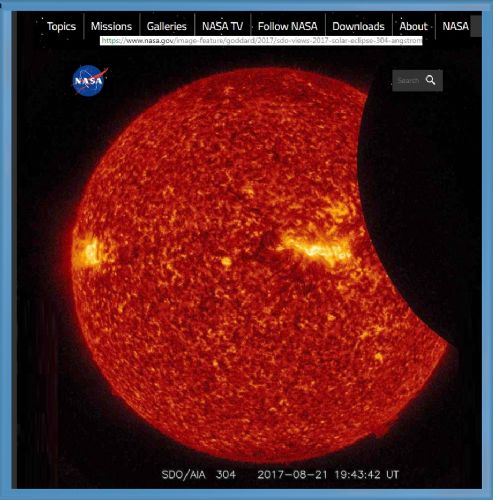
SDO
Views 2017 Solar
Aug. 21, 2017
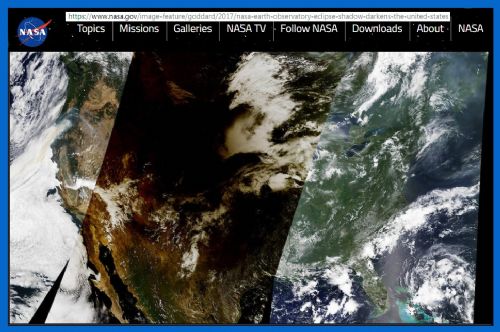
Eclipse
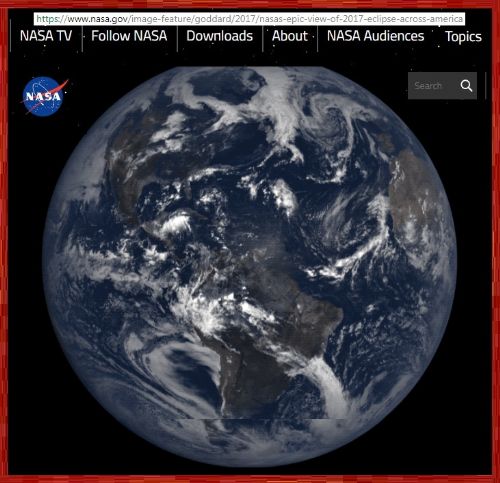
SDO
Views 2017 Solar Eclipse
Aug. 21, 2017
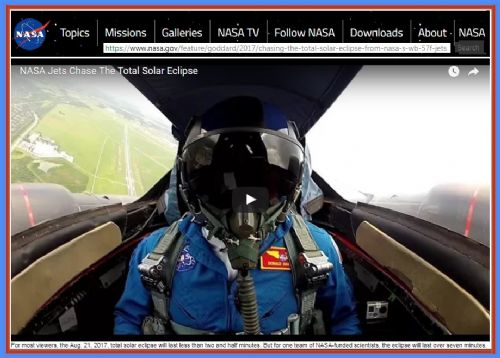
Aug. 17, 2017
Greatest Eclipse and
Greatest Duration:
What’s the Difference.?
During the total solar eclipse on Aug.
21, 2017, the Moon’s shadow will cross the United States from Oregon to South
Carolina in just an hour and a half. But the shadow won’t travel across the
country at the same speed. Instead, its speed will vary — and depending on
location, so too will the duration of totality, the fleeting minutes when the
Moon completely covers the Sun.
Two points along the shadow’s path are of
particular interest to eclipse viewers seeking the longest-lasting totality:
the point of greatest eclipse and the point of greatest duration. But neither
is necessarily greater than the other; with clear skies, any view of the corona
— the sun’s pearly-white, ethereal atmosphere — should be spectacular. So, what
is the difference between the two.? 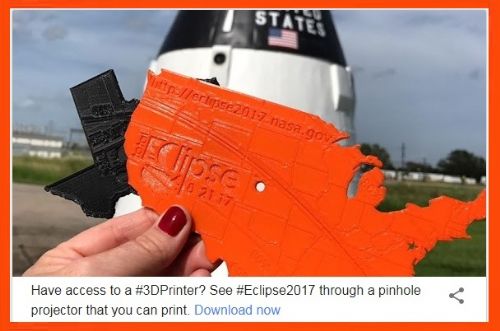
The point of greatest eclipse is where
the axis of the Moon’s shadow passes closest to the center of the Earth. Since
this is a strictly geometric concept, scientists use this point to compare
different eclipses with each other. For example, each eclipse on NASA’s
list of past and future eclipses is described by the date and time at its point of greatest
eclipse. The point of greatest eclipse for the Aug. 21 total solar eclipse will
see 2 minutes, 40.1 seconds of totality. The closest towns to this location are
Cerulean and Hopkinsville, Kentucky, which each will experience 2 minutes, 40
seconds of totality.
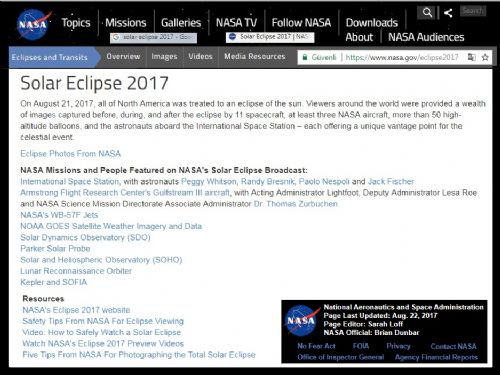
The point of greatest eclipse for the Aug. 21 total solar eclipse
will see 2 minutes, 40.1 seconds of totality.
Credits: Map data by
Google; eclipse calculations by NASA
On the other hand, the point of greatest
duration is where totality lasts the longest along the very center of the path
of totality. The greatest duration during the Aug. 21 eclipse is 2 minutes,
40.2 seconds near Makanda, Illinois. Carbondale, Illinois, is the closest large
town and will experience 2 minutes, 37 seconds of totality.
The greatest duration during the Aug. 21 eclipse is 2 minutes,
40.2 seconds.
Credits:
Map data by Google; eclipse calculations by NASA

Even though the Moon’s shadow travels at the same speed in space,
the shadow’s speed — and totality — varies in different places based on
geometry between Earth and the Moon.
Credits: NASA Goddard’s
Scientific Visualization Studio
Typically, the duration of totality at
greatest duration and greatest eclipse differs by just a few tenths of a
second. The geographic location may differ by 6 to 60 miles.
Even though the Moon’s shadow travels at
the same speed in space, the shadow’s speed — and totality — varies in
different places based on geometry between Earth and the Moon. The Moon casts
its shadow not on a flat surface, but a sphere — Earth. Toward either end of
the path of totality, Earth curves away from the Moon, so the shadow hits the
surface at an angle and elongates, covering a longer distance over a given time
period. Near the middle of the path of totality, when the shadow hits Earth
head-on, the shadow covers less ground in the same amount of time, so totality
lasts the longest.
For more information on the upcoming
total solar eclipse, visit: https://eclipse2017.nasa.gov
By Lina Tran
NASA's Goddard Space Flight Center, Greenbelt, Md.
Last Updated: Aug. 22, 2017
Editor: Rob Garner
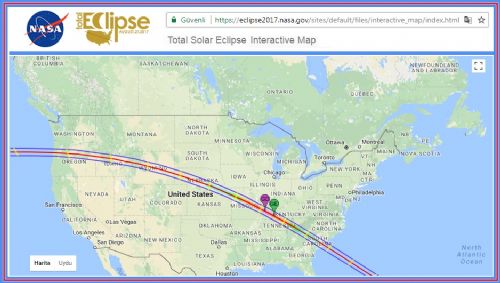
Aug. 14,
2017
Studying the Sun’s
Atmosphere with the Total Solar Eclipse of 2017
A total solar eclipse happens somewhere
on Earth about once every 18 months. But because Earth’s surface is mostly ocean, most eclipses are
visible over land for only a short time, if at all. The total solar eclipse of Aug. 21, 2017, is different – its path stretches over
land for nearly 90 minutes, giving scientists an unprecedented opportunity to
make scientific measurements from the ground.
When the Moon moves in front of the Sun
on Aug. 21, it will completely obscure the Sun’s bright face. This happens
because of a celestial
coincidence –
though the Sun is about 400 times wider than the Moon, the Moon on Aug. 21 will
be about 400 times closer to us, making their apparent size in the sky almost
equal. In fact, the Moon will appear slightly larger than the Sun to us,
allowing it to totally obscure the Sun for more than two and a half minutes in
some locations. If they had the exact same apparent size, the total eclipse
would only last for an instant.
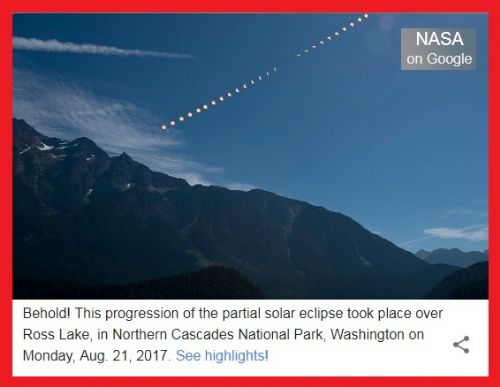
A total solar eclipse lets NASA researchers try out technology
that could one day aid in the development of future missions, however, they
must flawlessly complete the experiment in a few short minutes, two to be
exact.
Credits: NASA’s Goddard
Space Flight Center/Genna Duberstein
To download the video
The eclipse will reveal the Sun’s outer
atmosphere, called the corona, which is otherwise too dim to see next to the
bright Sun. Though we study the corona from space with instruments called
coronagraphs – which create artificial eclipses by using a metal disk to block
out the Sun’s face – there are still some lower regions of the Sun’s atmosphere
that are only visible during total solar eclipses. Because of a property of
light called diffraction, the disk of a coronagraph must block out both the
Sun’s surface and a large part of the corona in order to get crisp pictures.
But because the Moon is so far away from Earth – about 230,000 miles away
during the eclipse – diffraction isn’t an issue, and scientists are able to
measure the lower corona in fine detail.
NASA is taking advantage of the Aug. 21,
2017, eclipse by funding 11 ground-based science
investigations across
the United States. Six of these focus on the Sun’s corona. 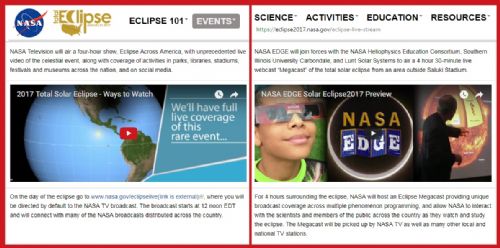
The Source
Of Space Weather
Our Sun is an active star that constantly
releases a flow of charged particles and magnetic fields known as the solar
wind. This solar wind, along with discrete burps of solar material known as
coronal mass ejections, can influence Earth’s magnetic field, send particles
raining down into our atmosphere, and – when intense – impact satellites.
Though we’re able to track these solar eruptions when they leave the Sun, the
key to predicting when they’ll happen could lie in studying their origins in
the magnetic energy stored in the lower corona.
A team led by Philip Judge of the High
Altitude Observatory in Boulder, Colorado, will use new instruments to study
the magnetic field structure of the corona by imaging this atmospheric layer
during the eclipse. The instruments will image the corona to see fingerprints
left by the magnetic field in visible and near-infrared wavelengths from a
mountaintop near Casper, Wyoming. One instrument, POLARCAM, uses new technology
based on the eyes of the mantis shrimp to obtain novel polarization
measurements, and will serve as a proof-of-concept for use in future space
missions. The research will enhance our understanding of how the Sun generates
space weather. 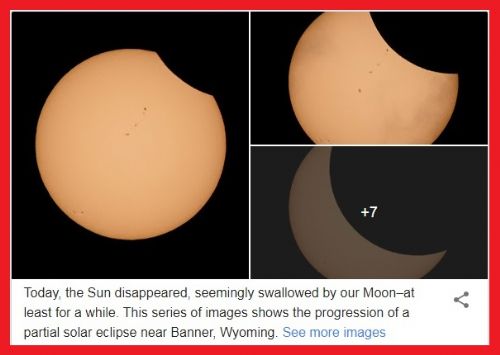
“We want to compare between the infrared
data we’re capturing and the ultraviolet data recorded by NASA’s Solar Dynamics
Observatory and JAXA/NASA’s Hinode satellite,” said Judge. “This work will
confirm or refute our understanding of how light across the entire spectrum
forms in the corona, perhaps helping to resolve some nagging disagreements.”
The results from the camera will
complement data from an airborne study imaging the corona in the infrared, as
well as another ground-based infrared study led by Paul Bryans at the High
Altitude Observatory. Bryans and his team will sit inside a trailer atop Casper
Mountain in Wyoming, and point a specialized instrument at the eclipse. The
instrument is a spectrometer, which collects light from the Sun and separates
each wavelength of light, measuring their intensity. This particular
spectrometer, called the NCAR Airborne Interferometer, will, for the first
time, survey infrared light emitted by the solar corona.
“These studies are complementary. We will
have the spectral information, which reveals the component wavelengths of light,”
said Bryans. “And Philip Judge’s team will have the spatial resolution to tell
where certain features are coming from.” 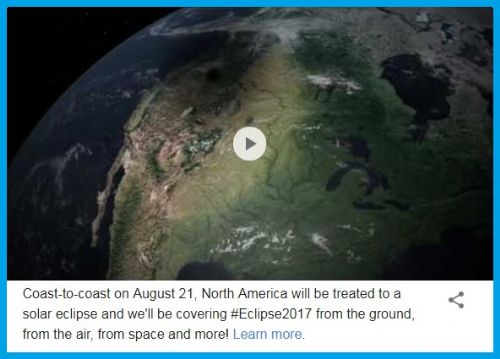
This novel data will help scientists
characterize the corona’s complex magnetic field — crucial information for
understanding and eventually helping to forecast space weather events. The
scientists will augment their study by analyzing their results alongside
corresponding space-based observations from other instruments aboard NASA’s
Solar Dynamics Observatory and the joint NASA/JAXA Hinode.
In Madras, Oregon, a team of NASA
scientists led by Nat Gopalswamy at NASA’s Goddard Space Flight Center in
Greenbelt, Maryland, will point a new, specialized polarization camera at the
Sun’s faint outer atmosphere, the corona, taking several-second exposures at
four selected wavelengths in just over two minutes. Their images will capture
data on the temperature and speed of solar material in the corona. Currently
these measurements can only be obtained from Earth-based observations during a
total solar eclipse. 
To study the corona at times and
locations outside a total eclipse, scientists use coronagraphs, which mimic
eclipses by using solid disks to block the Sun’s face much the way the Moon’s
shadow does. Typical coronagraphs use a polarizer filter in a mechanism that
turns through three angles, one after the other, for each wavelength filter.
The new camera is designed to eliminate this clunky, time-consuming process, by
incorporating thousands of tiny polarization filters to read light polarized in
different directions simultaneously. Testing this instrument is a crucial step
toward improving coronagraphs and ultimately, our understanding of the corona —
the very root of the solar radiation that fills up Earth’s space environment.
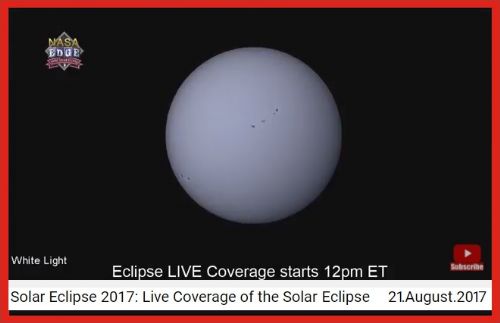
NASA’s Solar and Heliospheric Observatory, or SOHO, constantly
observes the outer regions of the Sun’s corona. During the Aug. 21, 2017,
eclipse, scientists will observe the lower regions of the sun’s corona to
better understand the source of solar explosions called coronal mass ejections,
as well as the unexpectedly high temperatures in the corona.
Credits: ESA/NASA/SOHO
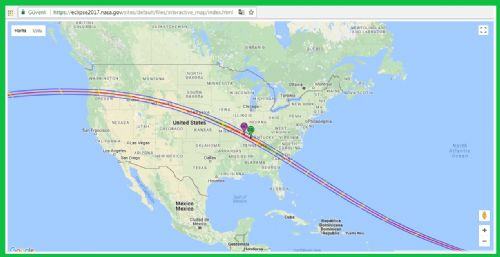
Unexplained Coronal Heating
The answer to another mystery also lies
in the lower corona: It is thought to hold the secrets to a longstanding
question of how the solar atmosphere reaches such unexpectedly high
temperatures. The Sun’s corona is much hotter than its surface, which is
counterintuitive, as the Sun’s energy is generated by nuclear fusion at its
core. Usually temperatures go down consistently as you move away from that heat
source, the same way that it gets cooler as you move away from a fire – but not
so in the case of the Sun’s atmosphere. Scientists suspect that detailed
measurements of the way particles move in the lower corona could help them
uncover the mechanism that produces this enormous heating.
Padma Yanamandra-Fisher of the Space
Science Institute will lead an experiment to take images of the lower corona in
polarized light. Polarized light is when all the light waves are oriented the same
way, and it is produced when ordinary, unpolarized light passes through a
medium – in this case, the electrons of the inner solar corona. 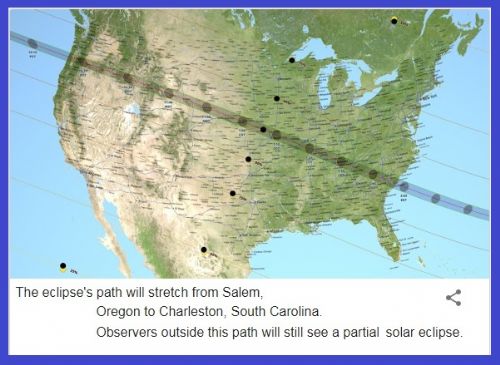
“By measuring the polarized brightness of
the inner solar corona and using numerical modeling, we can extract the number
of electrons along the line of sight,” said Yanamandra-Fisher. “Essentially,
we’re mapping the distribution of free electrons in the inner solar corona.”
Mapping the inner corona in polarized
light to reveal the density of elections is a critical factor in modeling
coronal waves, one possible source of coronal heating. Along with unpolarized
light images collected by the NASA-funded citizen science project called
Citizen CATE, which will gather eclipse imagery from across the country, these
polarized light measurements could help scientists address the question of the
solar corona’s unusually high temperatures.
Shadia Habbal of the University of
Hawaii’s Institute for Astronomy in Honolulu will lead a team of scientists to
image the Sun during the total solar eclipse. The eclipse’s long path over land
allows the team to image the Sun from five sites across four different states,
about 600 miles apart, allowing them to track short-term changes in the corona
and increasing the odds of good weather.
They will use spectrometers, which
analyze the light emitted from different ionized elements in the corona. The
scientists will also use unique filters to selectively image the corona in
certain colors, which allows them to directly probe into the physics of the
Sun’s outer atmosphere. 
With this data, they can explore the
composition and temperature of the corona, and measure the speed of particles
flowing out from the Sun. Different colors correspond to different elements —
nickel, iron and argon — that have lost electrons, or been ionized, in the
corona’s extreme heat, and each element ionizes at a specific temperature. By
analyzing such information together, the scientists hope to better understand
the processes that heat the corona.
Amir Caspi of the Southwest Research
Institute in Boulder, Colorado, and his team will use two of NASA’s WB-57F
research jets take observations from twin telescopes mounted on the noses of
the planes. They will capture the clearest images of the Sun’s outer
atmosphere — the corona — to date and the first-ever thermal images of Mercury,
revealing how temperature varies across the planet’s surface. 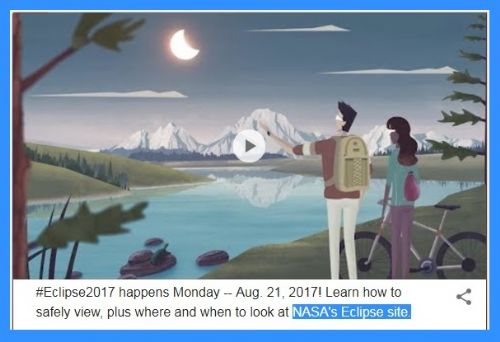
Read more about this study here.
Related:
NASA’s Eclipse 2017
website
NASA’s Eclipse news
stories
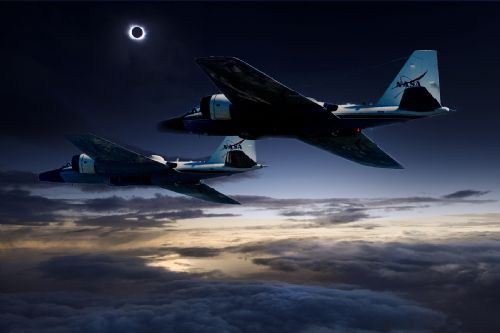
Caption
for banner image: A total solar eclipse gives scientists a
rare opportunity to study the lower regions of the Sun’s corona. These
observations can help us understand solar activity, as well as the unexpectedly
high temperatures in the corona. Credit: S. Habbal, M. Druckmüller and P. Aniol
By
Sarah Frazier
NASA’s Goddard Space
Flight Center, Greenbelt, Md.
Last Updated: Aug. 16, 2017
Editor: Lynn Jenner
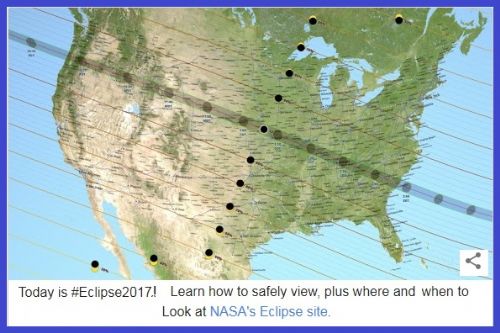
@ #Medya
Günebakış
Ökkeş Bölükbaşı, İstanbul – Ağustos.2017 – okkesb61@gmail.com,
http://www.medyagunebakis.com/ –– okkesb@turkfreezone.com,
https://twitter.com/okkesb ––––––– E.mail: okkesb@telmar.net,
https://www.facebook.com/okkes.bolukbasi,- okkesb@gmail.com,
Ökkeş Bölükbaşı, İstanbul – Ağustos.2017 – okkesb61@gmail.com,
 | 



